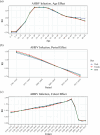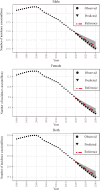Temporal trend analysis of acute hepatitis B virus infection in China, 1990-2019
- PMID: 38468382
- PMCID: PMC10964186
- DOI: 10.1017/S095026882400044X
Temporal trend analysis of acute hepatitis B virus infection in China, 1990-2019
Abstract
China faces challenges in meeting the World Health Organization (WHO)'s target of reducing hepatitis B virus (HBV) infections by 95% using 2015 as the baseline. Using Global Burden of Disease (GBD) 2019 data, joinpoint regression models were used to analyse the temporal trends in the crude incidence rates (CIRs) and age-standardized incidence rates (ASIRs) of acute HBV (AHBV) infections in China from 1990 to 2019. The age-period-cohort model was used to estimate the effects of age, period, and birth cohort on AHBV infection risk, while the Bayesian age-period-cohort (BAPC) model was applied to predict the annual number and ASIRs of AHBV infections in China through 2030. The joinpoint regression model revealed that CIRs and ASIRs decreased from 1990 to 2019, with a faster decline occurring among males and females younger than 20 years. According to the age-period-cohort model, age effects showed a steep increase followed by a gradual decline, whereas period effects showed a linear decline, and cohort effects showed a gradual rise followed by a rapid decline. The number of cases of AHBV infections in China was predicted to decline until 2030, but it is unlikely to meet the WHO's target. These findings provide scientific support and guidance for hepatitis B prevention and control.
Keywords: Bayesian age–period–cohort model; acute hepatitis B virus infection; age–period–cohort model; joinpoint regression model; temporal trend.
Conflict of interest statement
All authors confirm that there are no potential competing interests.
Figures





Similar articles
-
Trends and age-period-cohort effect on incidence of hepatitis B from 2008 to 2022 in Guangzhou, China.Sci Rep. 2024 Jun 11;14(1):13370. doi: 10.1038/s41598-024-63796-0. Sci Rep. 2024. PMID: 38862511 Free PMC article.
-
[Burden of hepatitis B-associated diseases in China from 1990 to 2030].Zhongguo Xue Xi Chong Bing Fang Zhi Za Zhi. 2023 Nov 30;35(5):464-475. doi: 10.16250/j.32.1374.2023068. Zhongguo Xue Xi Chong Bing Fang Zhi Za Zhi. 2023. PMID: 38148535 Chinese.
-
Secular Trends of Acute Viral Hepatitis Incidence and Mortality in China, 1990 to 2019 and Its Prediction to 2030: The Global Burden of Disease Study 2019.Front Med (Lausanne). 2022 Mar 11;9:842088. doi: 10.3389/fmed.2022.842088. eCollection 2022. Front Med (Lausanne). 2022. PMID: 35360747 Free PMC article.
-
Trends and projections of Hepatitis A incidence in eastern China from 2007 to 2021: an age-period-cohort analysis.Front Public Health. 2024 Dec 4;12:1476748. doi: 10.3389/fpubh.2024.1476748. eCollection 2024. Front Public Health. 2024. PMID: 39697280 Free PMC article.
-
Trends in the Incidence of Acute Hepatitis B in the Polish Population and Their Determinants.Medicina (Kaunas). 2021 Jul 22;57(8):738. doi: 10.3390/medicina57080738. Medicina (Kaunas). 2021. PMID: 34440944 Free PMC article.
Cited by
-
Age-period-cohort and bayesian age-period-cohort prediction modeling of hepatitis C incidence and mortality in China.BMC Public Health. 2025 Jun 4;25(1):2079. doi: 10.1186/s12889-025-22847-5. BMC Public Health. 2025. PMID: 40468268 Free PMC article.
-
Spatiotemporal evolution of HCV burden among women of reproductive age: a multinational age-period-cohort analysis.Virol J. 2025 Aug 2;22(1):265. doi: 10.1186/s12985-025-02869-6. Virol J. 2025. PMID: 40753224 Free PMC article.
References
-
- Hepatitis B Key Facts . Available at https://www.who.int/news-room/fact-sheets/detail/hepatitis-b (accessed 6 February 2023).
MeSH terms
LinkOut - more resources
Full Text Sources
Medical

